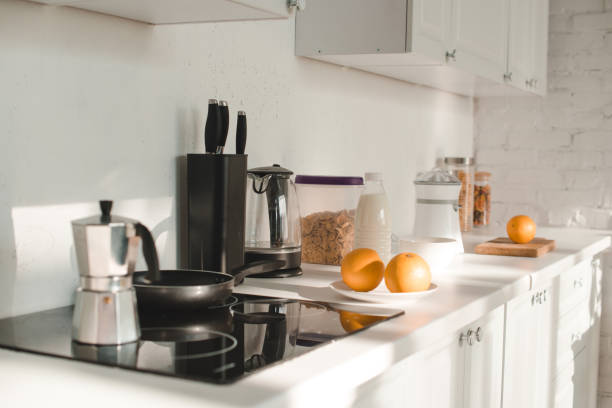How To Choose The Right Kitchen Knife?

Let’s start with the very first and most important thing – what kind of work do you need it for? The choice of Kitchen knife that you need will depend on this.
Types of kitchen knives
The European Chef Knife
The European Chef Knife is the main knife in the kitchen. It has a long blade, about 20 cm, but there are also longer models from 24 cm used for professional kitchens (for cutting ink). It is used for cutting any products: meat, fish, vegetables, and fruits.
The Santoku Japanese Chef Knife
The Santoku Japanese Chef Knife is the Japanese version of the European Chef Knife. The shape resembles a hatchet and the length of the blade does not exceed 17cm. It is used for cutting any products: meat, fish, vegetables, and fruits.
Slicing knives (Slicer)
Used for cutting meat and fish fillets. It features a narrow and long blade from 15cm to 30cm.
Fillet knives
used for cutting meat and fish fillets, they differ from a slicer in an even narrower and more flexible blade.
Nakiri
Best Nakiri Knife Designed for chopping vegetables and herbs. The shape resembles a hatchet, but it is not intended for chopping meat!
Yanagiba
professional knives with one-sided sharpening for cutting sushi and sashimi.
Boning knives
used for deboning meat, separating veins from meat, meat from bones.
Bread knife
A knife with a serrated blade, designed for cutting bread and other products with a hard crust and a soft middle (melon, watermelon, pineapple, etc.).
Frozen food knives
Are special saws that are used for cutting frozen food and bones.
Tomato knife
A knife for cutting tomatoes with a serrated blade.
Utility knife
Standard kitchen knives. It is used in contrast to the Chef knife for cutting any products, but already smaller. Blade length 12-15cm.
Vegetable knife
A small knife with a blade length of 8-10cm. It is used for peeling and cutting vegetables and fruits. Included in the “chef’s trio” along with the universal and chef’s knife.
Choice of knife material for the kitchen
So, when evaluating a material, we could use the name of the steel, but it is much more important to know its hardness – it is determined by the degree of hardening. To measure the final hardness, the Rockwell scale is used – where the hardest material diamond is taken as 100. Accordingly, this figure in the knife characteristic will mean the ratio to diamond hardness.
Read Extra: TOP 5 best Pocket knives 2022
So, the leader in hardness is ceramic knives, which are distinguished by terrible fragility, and does not allow even small blows. For comparison, ceramics are harder than steel. According to the Rockwell scale, ceramic knives have about 80 units of hardness, and therefore, these knives can keep sharpening for up to 2 years.
Further, in terms of hardness, knives with hardening from 60 units on the Rockwell scale follow – these are knives made of Damascus steel. However, to maintain elasticity, with such a degree of hardness, they are allowed by their layering. This structure allows them to be as hard as possible and at the same time not brittle, since the hardest layer (about 60-63 units) is located in the center of the knife, and then softer layers are located, allowing the knife to be resistant to side loads and impacts. However, certain difficulties may arise during sharpening, since the knife is complex in structure, and yet it has a high hardness.
Hardening-hardness
The most optimal level of hardening-hardness is 56-59 units, and it is used in the production of single-layer knives. Such a knife will retain sharpening for a long time, but at the same time, it will be plastic and resistant to damage. Also, these knives lend themselves to self-sharpening, due to sufficient softness.
Knives with hardening of fewer than 56 units are classified as soft knives. These knives will need to be sharpened frequently. You can find this characteristic in the description of any knife, and the lack of data on it rather indicates low-quality steel with low hardness.
The presence of a bolster
This is the name of the metal thickening located between the blade itself and the handle. If you see this with a knife, you can feel that in the hand such a knife maintains balance better.
However, for many, it will be more valuable to know that thanks to it, bacteria will practically not collect under the handle of the knife. So cooks in almost all restaurants undertake to work with all-metal knives so that bacteria do not settle anywhere in the knives.
Protective guard
If you pay attention to the shape of many Japanese knives, such as the chef knife, you will see that on the inside of the blade, the base has a sharp angle, this angle is called the “knife heel”. If this heel is sharp, then we often “run into” it with our fingers. However, this problem is solved by the presence of a rounded metal edge on the knife, which is called the “protective guard”.
In addition to protection, this cushioned edge, which usually has a slightly convex shape, allows you to hold on to it. This will be convenient if you hold the knife with a chef’s grip when cutting.
Handle material and shape
- We will mention the main materials that are on the market and which are characteristic of a good knife.
- Modern plastic G-10, which is used in the handles of most knives, is highly durable and resistant to moisture and detergents. It is also used in folding tourist knives, and in the space industry too.
- Wooden handles are more responsible for comfort and non-slip in the hand. In addition, it is certainly a beautiful material, which often distinguishes impractical things. Speaking of impracticality, such knives do not withstand prolonged contact with moisture, so washing in a dishwasher is contraindicated! Although we recommend washing all knives by hand, the strong pressure and harsh abrasives or detergents do not spare the thin edge of any knife.
- Rubberized handles are a good alternative to plastic ones, as there is no slip. Moreover, the moisture resistance is the same as that of plastic.
- Finally, Micarta is durable, resistant to abrasives, and often comes in unusual colors to complement your kitchen design.
Read More: CHOOSING A DAMASCUS KNIFE FOR THE KITCHEN





